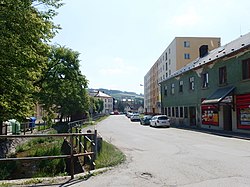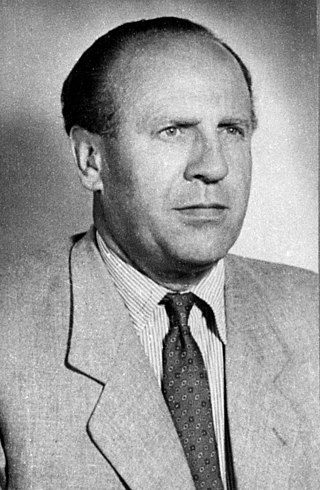
Oskar Schindler was a German industrialist, humanitarian, and member of the Nazi Party who is credited with saving the lives of 1,200 Jews during the Holocaust by employing them in his enamelware and ammunitions factories in occupied Poland and the Protectorate of Bohemia and Moravia. He is the subject of the 1982 novel Schindler's Ark and its 1993 film adaptation, Schindler's List, which reflect his life as an opportunist initially motivated by profit who came to show extraordinary initiative, tenacity, courage, and dedication in saving his Jewish employees' lives.
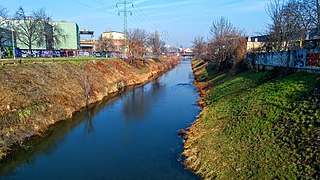
The Svitava is a river in the Czech Republic, a left tributary of the Svratka River. It flows through the Pardubice and South Moravian regions. It is 98.4 km (61.1 mi) long.

Pardubice Region is an administrative unit of the Czech Republic, located mainly in the eastern part of its historical region of Bohemia, with a small part in northwestern Moravia. It is named after its capital Pardubice. As an administrative unit, Pardubice Region has existed three times in the course of history. It was established for the first time in 1850, and extended from Český Brod to the Bohemian-Moravian border. In its second existence, it was one of 19 regions as they were set between 1949 and 1960. After 1960, Pardubice became the capital of Pardubice district, which was part of the Eastern Bohemian Region. The Pardubice Region, as it is now, was reestablished in 2000.

Emilie Schindler was a Sudeten German-born woman who, with her husband Oskar Schindler, helped to save the lives of 1,200 Jews during World War II by employing them in his enamelware and munitions factories, providing them immunity from the Nazis. She was recognized as Righteous Among the Nations by Israel's Yad Vashem in 1994.
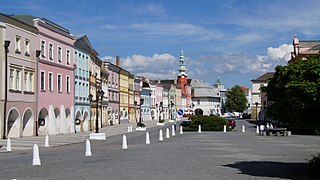
Svitavy is a town in Svitavy District in the Pardubice Region of the Czech Republic. It has about 16,000 inhabitants. It is the birthplace of Oskar Schindler and the centre of the Czech Esperanto movement. The historic town centre is well preserved and is protected by law as an urban monument zone.

Adamov is a town in Blansko District in the South Moravian Region of the Czech Republic. It has about 4,500 inhabitants. Historically it is known as an industrial town. The former industrial area of Stará Huť is protected by law as a monument reservation.

Česká Třebová is a town in Ústí nad Orlicí District in the Pardubice Region of the Czech Republic. It has about 15,000 inhabitants. The historic town centre is well preserved and is protected by law as an urban monument zone.
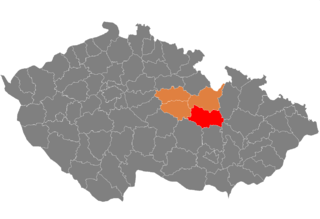
Svitavy District is a district in the Pardubice Region of the Czech Republic. Its capital is the town of Svitavy.

Moravská Nová Ves is a market town in Břeclav District in the South Moravian Region of the Czech Republic. It has about 2,600 inhabitants.

Moravská Třebová is a town in Svitavy District in the Pardubice Region of the Czech Republic. It has about 9,700 inhabitants. The historic town centre is well preserved and is protected by law as an urban monument reservation.

Blansko District is a district in the South Moravian Region of the Czech Republic. Its capital is the town of Blansko.

Letovice is a town in Blansko District in the South Moravian Region of the Czech Republic. It has about 7,200 inhabitants.

Březová nad Svitavou is a town in Svitavy District in the Pardubice Region of the Czech Republic. It has about 1,600 inhabitants.
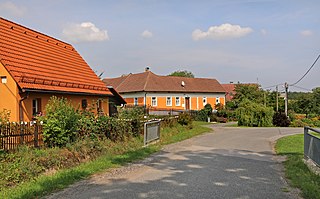
Janůvky is a municipality and village in Svitavy District in the Pardubice Region of the Czech Republic. It has about 70 inhabitants.

Kamenná Horka is a municipality and village in Svitavy District in the Pardubice Region of the Czech Republic. It has about 400 inhabitants.

Městečko Trnávka is a municipality and village in Svitavy District in the Pardubice Region of the Czech Republic. It has about 1,400 inhabitants.

Radiměř is a market town in Svitavy District in the Pardubice Region of the Czech Republic. It has about 1,200 inhabitants.

Rozhraní is a municipality and village in Svitavy District in the Pardubice Region of the Czech Republic. It has about 300 inhabitants.

Svitávka is a market town in Blansko District in the South Moravian Region of the Czech Republic. It has about 1,900 inhabitants.

The Brünnlitz labor camp was a German forced labor camp which was established in 1944 just outside the town of Brněnec, Sudetengau. It operated solely as a site for an armaments factory run by the German industrialist Oskar Schindler, which was in actuality a front for a safe haven for Schindlerjuden. Administratively, it was a sub-camp of the Gross-Rosen concentration camp system.
